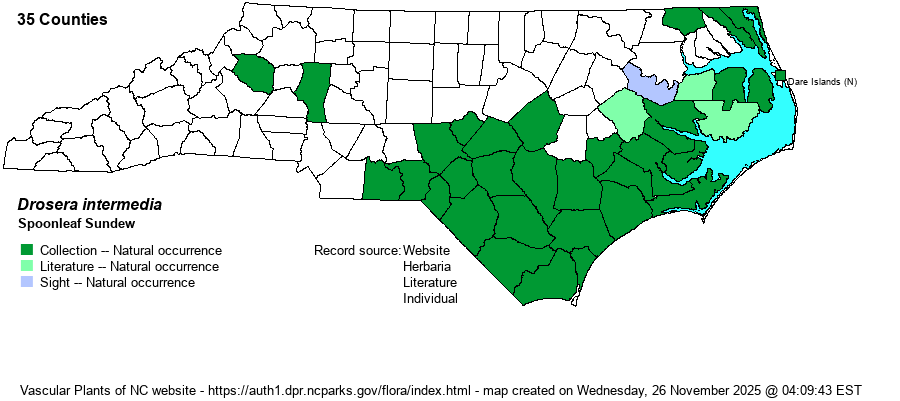| Author | Hayne | |
| Distribution | Occurs essentially across the southern half of the Coastal Plain; also sparingly into the northern Coastal Plain, where there are some records for counties north of Albemarle Sound. In addition, there are a few records for the extreme southeastern Piedmont and two counties in the western Piedmont. Thus, the range is very similar to that of Droserea capillaris.
This species has a very wide range in eastern North America, hardly restricted to the Coastal Plain regions. It ranges across southern Canada south to southern FL and extreme eastern TX; however, south of MN, northern IL, and NY it is scarce west of the Coastal Plain, though there are records for all Eastern states. | |
| Abundance | Fairly common, to locally common, in protected natural areas in the southern Coastal Plain, but uncommon to infrequent away from such places in that region. Quite rare in the northern Coastal Plain, and very rare in the Piedmont portion of the range. | |
| Habitat | This species prefers to grow in shallow standing water, of pools, ditches, scrapes in or near savannas, pocosin openings, and pond margins. It does grow in pine savannas, but as with others in the genus it usually is not found in grassy places, as the plants can become easily shaded out by taller vegetation. | |
| Phenology | Blooms in mid- and late summer, typically from July into September. Fruits shortly after flowering. | |
| Identification | This is the only NC sundew with an upright to generally erect central stem, with leaving coming off diagonally to less often horizontally from this stem. However, younger plants may not have (yet) this stem emerging out of the ground, and thus you will simply see leaves generally angling upward from a central spot. Thankfully, its leaves are often 2-3 inches long, with the very narrow petiole -- filiform in width -- being about 3/4 to 4/5 of the leaf length (i.e., often close to 2 inches long). The blade at the end of the leaf is elliptical and very sticky, with typical sundew glands. The whole plant is usually red-tinged, as are many other sundews. The flowering scapes are glabrous, and usually extend slightly taller than the leaves; the numerous flowers on the spike are typically white and about 1/2-inch across. Usually there is just a single flower in bloom at a time on any single stalk. The only species it should be confused with is D. capillaris, at least when it is just coming up and not fully mature. However, the latter species usually has pink flowers, and the leaf petioles are not filiform and are almost always under 1-inch long. D. intermedia is usually rather easy to find when you are in the southern Coastal Plain and working in savannas or other acidic wetlands; usually its "bushy" look is sufficient for identification. | |
| Taxonomic Comments | None
| |
| Other Common Name(s) | Water Sundew, Oblong-leaved Sundew, Spathulate-leaved Sundew | |
| State Rank | S4 | |
| Global Rank | G5 | |
| State Status | | |
| US Status | | |
| USACE-agcp | OBL link |
| USACE-emp | OBL link |

